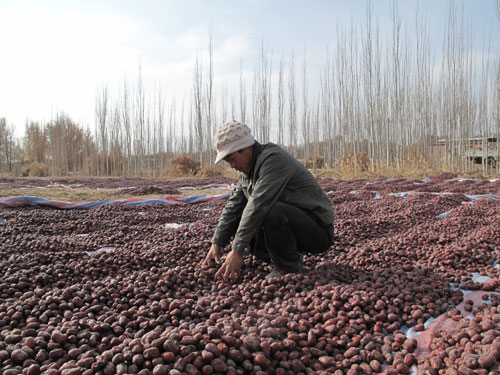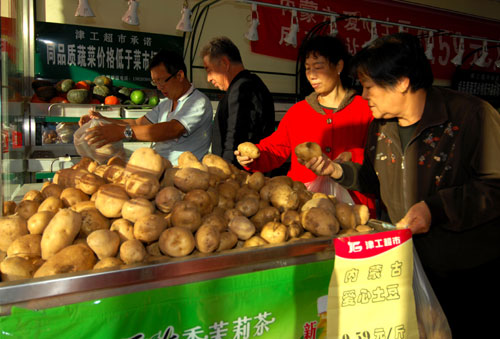The grapes of wrath
Updated: 2011-12-12 15:53
By Shao Wei and Qiu Bo (China Daily)
|
|||||||||||
Farmers at the mercy of market turmoil and the weather as prices for crops continue to fall, Shao Wei reports from Xinjiang and Qiu Bo from Beijing.
|
 |
|
Tang Jianbo, 26, a farmer in Alaer in Northwest China's Xinjiang Uygur autonomous region, checks dried jujubes in his field before loading them onto a truck for delivery to Shanxi province. [Shao Wei / China Daily] |
There's a saying in the West that you can make a small fortune in farming, provided you start with a large one. Chinese farmers would understand.
Price turmoil hit cotton, cabbage and potato crops this year and is leading jujube farmers to sell crops well below cost or store them over the winter, adding to their expenses.
"We have to get rid of our jujubes before they start rotting," farmer Tang Jianbo said. "They are 6 yuan (95 US cents) per kilogram now, while last year they were 22 yuan at least!"
The price of ginger has also fluctuated wildly over the last five years and speculators last year fueled huge swings in garlic, apple and mung bean prices.
The government guarantees minimum prices each year for the critical wheat, rice and corn crops. But most farmers are at the mercy of the market. And the weather, which often affects prices. Greater knowledge of the market and better channels of information would help, some experts say. So might changes in the ways crops are sold.
Farmers seldom expect to get rich, but they'd like at least a little profit and consistency.
Jujubes are sweet fruit, similar to dates, that are sold fresh or dried. Chinese consider them antianemic and good for the skin, and the fruit is popular in inland China.
Tang, 26, farms 25 mu (1.7 hectares) of jujube trees at Alaer Farm in Northwest China's Xinjiang Uygur autonomous region. On a recent Sunday, he was loading dried fruit from his field onto a truck heading to Shanxi province.
The orchard is in southern Xinjiang's Aksu prefecture, which is famous for its high-quality jujubes and melons. The farm, operated by the Xinjiang Production and Construction Corps in Alaer city, has about 21,300 hectares of jujube orchards. Output this year was 23,800 tons.
"The 25 mu of jujubes cost me about 80,000 yuan ($12,600) to grow. Now I'm selling them at 50,000 yuan total," Tang calculated. "I am suffering a heavy loss."
Even so, Tang considered himself lucky. Most of his neighbors, who couldn't bear the steady drop in wholesale price when jujubes ripened, dumped their fruit in late November for 4 to 5 yuan per kg.
Tang figured about 95 percent of jujube growers at the farm made no money this season.
|
 |
|
Residents in Tianjin buy potatoes in a market that supports farmers from Inner Mongolia. The shoppers get a discount, too.[Zhang Chaoqun / Xinhua] |
It's not just fruit
Potato prices hit their lowest level in a decade in October, at 0.70 yuan (10 US cents) a kg in North China's Inner Mongolia autonomous region. The price in Ulanqab, which calls itself the "potato capital" of China, last year was 2 yuan a kg.
Farmer Sun Guanbing said in October that he sold only a quarter of his yield. "I earned some 30,000 to 40,000 yuan last year," Sun said, "but I will probably suffer at least a 20,000 yuan loss this year.
Prices elsewhere in North China dropped an average of 35 percent from February to October, as much as 58 percent in Heilongjiang province and Beijing.
Meanwhile, figures released by the Ministry of Commerce indicate the wholesale price for ginger nationwide has dropped more than 50 percent this year, from 7.24 yuan a kilogram at the start to 3.42 yuan on Friday.
Zhao Shunping, a grower in Tai'an, East China's Shandong province, was quoted by China Business News as saying it is very difficult to predict market price, though he has been dealing ginger in the market for 20 years. "Growing ginger is more like speculating in the stock market."
Wang Haisong, a cotton farmer from Jiangsu province, told China Daily he feels the same way. Though his yield this year increased slightly, his income fell by 2,500 yuan. "The market price drops to the ground while the cost goes up."
The garlic roller coaster ride began at the end of 2009 and peaked last year "when some opportunist speculators sought to jack up the price of garlic," said Wang Chuan, a researcher in the Agricultural Information Institute at the Chinese Academy of Agricultural Sciences.
Speculators took advantage of the relationship between supply and demand, said one in Shandong who gave only his surname, Qin. When the price, which had been steady at 1 yuan a kilogram, slumped to 0.1 yuan, he said, speculators perked up.
Qin, a wholesaler, signed deals with garlic growers promising to buy their crop at the relatively high price of 3,000 to 4,000 yuan for every mu when it ripened. Then he sold his contracts, covering 97 mu, for more than 7,000 yuan a mu. And those buyers stored the garlic, selling it for much more. The retail price increased a hundredfold within two years, growing more expensive than meat.
War with wholesalers
"The turmoil in the jujube market makes us farmers bite the bullet," said Ma Guojun, a planter at Alaer Farm who has cultivated 15 hectares of jujube trees for six years. "An unexpected, shocking low price," Ma said. "I've never seen the price of Xinjiang jujubes so low before."
Ma blamed wholesalers and packinghouses from inland China that wait things out and "deliberately lower the price".
Jujubes have a short window for sale and eating fresh, and are vulnerable on long trips to market. A bad jujube can cause a truckload to rot within a couple of days. Farmers' best option, then, is to dry them on sandy fields. In less than three weeks "under the dry winter sunshine in southern Xinjiang, . . . a jujube will lose 30 to 40 percent of its water content," Ma said.
"Farmers have no time to wait for the price to rise, as rain or snow can easily damage our whole year's hard work," Ma said. "Selling them as soon as possible is the only way out." The wholesalers get good-quality dried jujubes for less money.
"It's like a tug of war between farmers and wholesalers every winter, and we farmers are always the underdogs."
Toll of inexperience
Xinjiang has a relatively short history in large-scale planting, said Yang Zhiyong, head of the Shanxi Jujube Wholesalers Association in Aksu prefecture. Hotan in Xinjiang introduced saplings from Henan province in 2000 and Aksu from Shanxi province in 2005.
Since then, jujubes have become a pillar industry and cash cow for future economic development in poverty-stricken southern Xinjiang. But the farmers still "lack both planting and marketing experience", Yang said.
The threshold for providing jujubes directly to supermarkets is still too high and complicated for individual farmers in Xinjiang, according to Lin Shu'an, who has worked in wholesale fruit more than 20 years. "Processing, preserving, transporting and marketing . . . All these need money and technology. Farmers here are too weak to manage it."
Lin, originally from Henan province, opened a jujube packinghouse in Alaer city in 2006. It has a processing capacity of 500 tons, but he said it can't match jujube production, which grew this year to nearly 134,000 hectares in Aksu.
"Over 80 percent of Xinjiang's jujubes are packaged inland. Thus, most of the benefits gained from them have been gained by inland intermediaries," Lin said.
Despite the drop at wholesale markets, retail prices of top-quality Xinjiang jujubes remain high - roughly 160 to 200 yuan a kilo at dried food markets in inland China. Yang figured the average retail price at 120 yuan a kilo for Xinjiang's jujubes, compared with 6.5 yuan for the same variety from Shanxi.
Yet the lack of experience and proper management made many Xinjiang jujube planters lose in the inland market, Yang said.
Deciding in a vacuum
The rising cost of living has triggered a ripple that affects growers who want to sell their produce in cities' markets. They pay higher market administrative charges, more in rent for market stalls and so on.
Speculation through price fluctuation is a real lure to them.
Predicting a market, whether for produce or stocks, is always tricky. But most farmers don't have access to enough information to make an educated guess. Many had limited schooling, they aren't equipped to check information via computer, and local agricultural offices are often less active than their counterparts in other countries.
For example, said Wang Chuan, the agricultural information researcher, farmers around Hebei province's Shijiazhuang planted 40 percent more land in Chinese cabbage this year because prices last year reached 3,500 to 3,800 yuan per mu on average. Then the price slipped to the current 500 to 600 yuan, about a half-yuan for each cabbage.
"The price of a regular pack of fertilizer has grown from 180 yuan to 200 yuan," Wang said, "and the labor cost in the fields almost doubled in a year. Nothing is left in profit for the farmers."
Zhang Tingyin, an economics professor at the Henan Provincial Committee Party School, calls their problem "information asymmetry." He explained: "They didn't realize many competitors were doing the same thing when they expanded the growing of crops that they felt strongly would go up in price. They just followed their sense of intuition."
Li Guoxiang, from the Chinese Academy of Social Sciences' Rural Development Institute, said the farmers based their decisions on market price at the time, "whereas the relation between supply and demand reversed when the commodity was placed in the market, and it easily led to the significant price fall."
Four ideas
In keep such predicaments from recurring, Wang Chuan suggested that governments help to establish more rural cooperatives. "Such cooperatives gather growers together in collectivized planting and selling, which will lower the cost and reduce the risk for the scattered production."
Wang said that by the end of June, the country had established some 446,000 rural cooperatives. But only 36 million rural households, 14 percent of the total, had joined such civil organizations.
In Henan province, local governments have helped in the formation of nonprofit associations or other groups such as the watermelon or garlic association. Their strengths are in providing information and training to help farmers avoid market risk.
"They work to a certain extent because farmers can timely acquire accurate market information," Zhang said. "Diesel fuel, highway tolls, packing costs . . . the farmer's margin has been squeezed in almost every channel."
From March to May, the Ministry of Commerce issued consecutive regulations urging authorities to allow growers to sell raw agricultural products in urban communities after a quality check. But some cities' restrictions don't support such independent operations.
"The farmers expect more preferential policies to better fall into place," Wang said.
Japan is one of the countries that have maintained stable market prices. The government has encouraged centralized trade for agricultural produce, which allows easier price adjustments. The government also is quick to disseminate information about supply and demand to both farmers and consumers.
Cang Wei contributed to this report. Write to the reporters at qiubo@chinadaily.com.cn and shaowei@chinadaily.com.cn.








